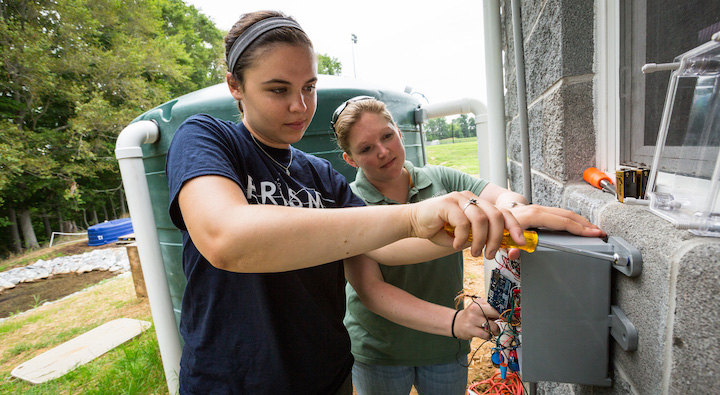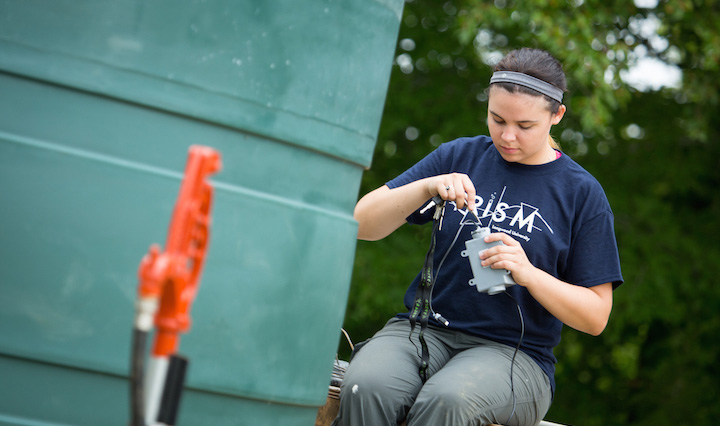

Computer technology is helping Mother Nature in a Longwood research project.
For conserving water, a full rainwater cistern—a tank that collects and stores rainwater—is ideal. Unfortunately, though, a full cistern cannot prevent the roof runoff that otherwise becomes stormwater runoff. One way to address these conflicting objectives is through the use of a real-time control (RTC) device that triggers the release of stored water based on National Weather Service forecasts. Releasing water in advance of a rain event enables the system to capture the forecasted amount of rainfall and, ideally, prevent overflow from occurring during the storm event.
Outside the environmental education center at Lancer Park, Rachel Lombardi ’16 and Dr. Kathy DeBusk Gee recently installed such a "smart" system and are monitoring its effectiveness in stormwater management and water conservation. Their work is part of the PRISM summer research program.
"We’re investigating how the incorporation of a RTC device impacts a system’s performance," Gee, area coordinator of the integrated environmental sciences major, told a visitor to Lancer Park one morning in June. "We’re trying to maximize the stormwater mitigation aspect of a rainwater harvesting system in addition to the traditional component of water conservation."
The rainwater harvesting system that she and Lombardi have designed and created—based on one the professor worked on previously—will be used for irrigation, toilet flushing and other nonpotable tasks.

On the first day of the PRISM program, a 3,000-gallon cistern—8 feet in diameter and about 8 feet high—was installed just outside the environmental education center. Rainwater feeds into the cistern through two underground pipes connected to downspouts on the building.
"The cistern’s job is to collect rainwater and use it for another purpose. It’s essentially a big rain barrel," said Gee, whose specialty is on-site stormwater management.
Water is released only when there is insufficient storage capacity within the cistern to accommodate the forecasted precipitation, preserving the system’s water conservation function, said Gee. Additionally, the drawdown occurs prior to a storm, so runoff to the storm drainage system is greatly reduced or eliminated.
When Gee and Lombardi were interviewed on-site during the fourth week of PRISM, two Facilities Management employees were helping them install a rain gauge on the roof of the environmental education center. The gauge, which will be connected to the RTC by a wire, will be used to monitor rainfall characteristics at the site.
The RTC, not yet installed, is being developed by Lombardi and three computer science students of Dr. Robert Marmorstein, assistant professor of computer science. "It will operate a valve next to the tank and will discharge water into the rain garden," Gee said of the controller, which will be mounted on the outside of the building near the cistern.
Two grants from the Piedmont Soil and Water Conservation District covered the cost of the cistern and nearby rain garden, which will feature native Virginia plants. Ironically, rain in early June was slowing work on the garden and other work in the project.
"If it will quit raining, we can build the rain garden in two or three days," Gee said with a laugh when asked how long that would take.
Lombardi, an integrated environmental sciences major from Marlton, N.J., plans to study physical geography in graduate school and work as an environmental consultant. She is especially interested in surface waters and watersheds.
"I’ve enjoyed seeing this project evolve from a lab setting to the field, and I’ve enjoyed the hands-on aspect," she said. "I’ve also liked crunching numbers—this involves lots of calculations—and seeing the tank fill up with water for the first time. In case there’s construction later, I’ve done photo-documenting so we’ll know where the pipes are. I’ve done some digging and gotten my hands dirty, though eventually I’ll go back to crunching numbers.
"I’m learning a lot; I’m learning what Dr. Gee does. It’s great to see when things go wrong and when they go right. I’m learning hands-on life skills from Dr. Gee, who is my mentor in my major."
In her dissertation, Gee conducted a pilot project in which a smart rainwater harvesting system was installed at Tryon Palace in New Bern, N.C. That system, she said, reduced the volume of stormwater by an average of 88 percent. Average peak flow rates of stormwater leaving the site were reduced by 93 percent.
"This is the epitome of applied research, which is what I love the most," she said of her PRISM project. "This system will be an educational tool for not only Longwood but also for the community. This will be a great place to come to and learn about rainwater harvesting."
